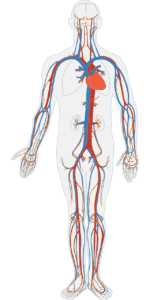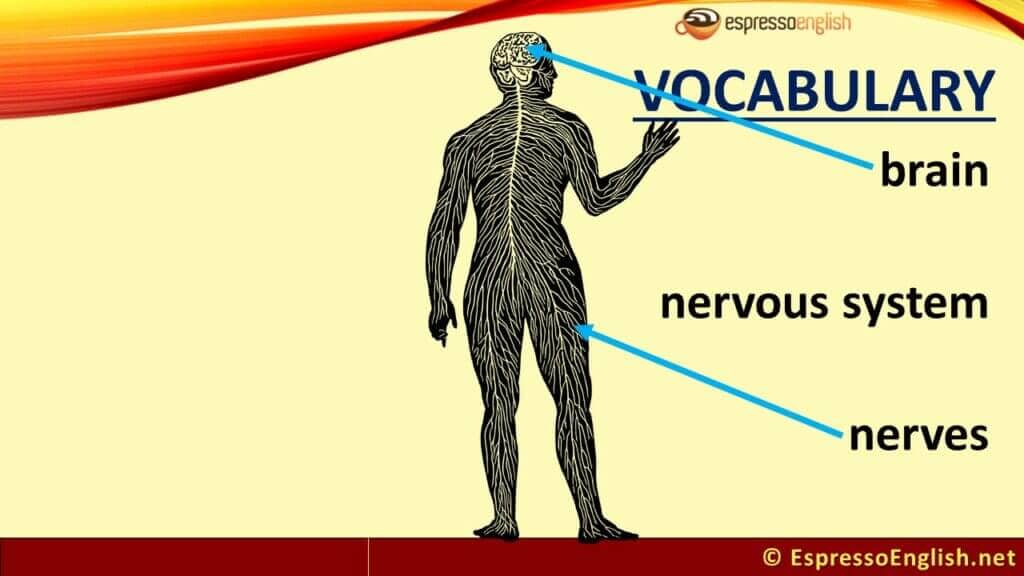
Let’s learn some human body vocabulary! You probably already know basic English words for parts of the body – eyes, ears, shoulders, arms, legs, and so on. But do you know these 40 words for what’s inside your body?
This will be a visual vocabulary lesson – I’ll show you pictures to help teach you the words. Learning vocabulary with pictures actually helps you remember it better. That’s why I also use lots of pictures inside my Vocabulary Builder Courses – they have more than 1,000 words in each level, helping you expand your vocabulary fast so you can express yourself more fluently in English.
Let’s begin with the circulatory system. Your heart pumps blood to your entire body through arteries (which carry blood away from the heart), veins (which carry blood back to the heart), and capillaries (very tiny blood vessels).

The blood is oxygenated in your lungs. When you breathe, the air goes through your trachea (which is more commonly called your windpipe). The verb for breathing in is to inhale, and the verb for breathing out is to exhale.

Your skeleton is made of 214 bones. The places where two bones come together are called joints (for example: your knees, elbows, wrists, ankles, shoulders, etc.)
Here are some of the most common parts of the skeleton: Your skull is the bones of your head and face, your clavicle or collarbone runs from your neck to your shoulder, your ribs protect your heart and lungs, your spine is the long column of bones going down your back, and your pelvis connects your spine to your legs.

Your muscles and bones are connected by ligaments (which connect bone to bone) and tendons (which connect muscle to bone):

Of course, what controls everything is your brain, which sends signals to the rest of your body through the nervous system, which is made up of connections called nerves.

Now let’s look at the digestive system. When you eat, food goes into your mouth, passes through your throat and goes down your esophagus. The food is digested in your stomach, then passes through your small intestine and large intestine before being eliminated from the body.
A few more important internal organs include the pancreas, which produces hormones and enzymes; the liver, which filters your blood and removes poisonous substances, and the gallbladder, which stores a substance called bile that helps us digest fat in our diet.

Your kidneys remove wastes and extra fluids from your blood, which they send to the bladder to be eliminated in urine.
Finally, we have the reproductive system. Men have two testicles which produce sperm, the cells that carry the male’s genetic material. Women have two ovaries, which produce eggs carrying the woman’s genes. The eggs travel through the fallopian tubes to the uterus (often called the womb) – this is where a baby can grow and develop.

The umbilical cord connects the mother to the baby through the baby’s navel or belly button.

These are the human body vocabulary words that are in general and common use; if you’re studying to be a doctor or nurse, then you might need a more advanced list of words for anatomy – you can find more at medicalenglish.com
But if you’re learning English for general reasons, you’re not in the medical field, then I’d encourage you to take the next step in your learning by joining my Vocabulary Builder Courses. You’ll easily learn lots of vocabulary in many different areas, so that you can speak more confidently about various topics – without pausing and trying to think of the right word.
There are two levels of the vocabulary builder – Level 1 is a little easier, and Level 2 is a little more challenging – and there’s a discount if you join both together.
Thanks for joining me for today’s human body vocabulary lesson; I hope you enjoyed it and learned some new words in English!
Want to increase your vocabulary
& improve your fluency?











